The Basilica of St. Mark and the Treasures of Constantinople
Nothing quite prepares you for the spectacle of seeing the interior of the Basilica of St. Mark for the first time. A symbol of Venetian majesty, wealth, and power, the Basilica has also been referred to as the Church of Gold.
* And for good reason! This was probably how the Hagia Sophia in Istanbul (then Constantinople) looked like before it was defaced and converted into a mosque.
* Legend has it that Venetian merchants somehow came across the relics of St. Mark the Evangelist in Alexandria, Egypt, stole them, and brought them to Venice.
* St. Mark's relics currently rest underneath the altar of the Basilica, surrounded by gorgeous alabaster columns depicting scenes from the New Testament.
* There are over 4,000 square meters of gold mosaics laid out in Byzantine-style; featuring scenes and holy people from the Bible, adorning the walls of the Basilica. Quite mind-boggling!
* However the most important piece is the Pala d'Oro, an altarpiece made of 250 pure gold panels, silver, and precious stones. Arguably, the finest altarpiece in all of Europe!
* You want a definite number?! Okay.. 526 pearls, 330 garnets, 320 emeralds, 255 sapphires, 183 amethysts, 175 agates, 75 rubies, 34 topazes, 16 carnelians, and 13 jaspers.
* Built in 828 AD, the Basilica originally served as the private chapel of the Venetian Doge, whose palace is right next door. (See: Palazzo Ducale - Doge's Palace)
* Today the Basilica is the cathedral church of the Roman Catholic Archdiocese of Venice and seat of the Patriarch of Venice.
* However, the grandeur of the Basilica and everything in it hides a dark history.
* For it is also full of looted statues, icons, religious treasures, and relics; all stolen from Constantinople.
* Such as the Horses of Saint Mark, which once stood proudly at the Hippodrome of Constantinople.
So how did this looting even happen?!
* Once upon a time the Roman Empire ruled the known world, but when it got too big it broke off into two Empires.
The Western Roman Empire (whose seat was in Rome) covered the area now made up of Spain, France, England, and Italy. Its religion was Roman Catholicism.
The Eastern Roman / Byzantine Empire (whose seat was in Constantinople) covered the area now made up of Greece, Turkey, Egypt, and the Holy Land. Its religion was Greek Orthodox Christianity.
* Through the Centuries, the Western Roman Empire further broke off into various kingdoms, while the Byzantine / East Roman Empire stayed strong and intact, only losing territory in the Holy Land to the Arabs.
In fact from the 5th century to 13th century, Constantinople was the wealthiest city in Europe.
* The campaigns to reconquer the Holy Land from the Muslims became known as the Crusades. Various Christian Kingdoms united to recapture the land of Christ.
* To get to the Holy Land though, the Christians could either sail from the coastal cities of Italy or march through Byzantine territory, in the area now known as Turkey.
* Things took an ugly turn when in 1204 AD, on the 4th Crusade, the Crusaders with their Venetian sailors got involved in Byzantine politics thereby turning their attention to Constantinople, capital of Byzantium.
* Upon orders of the Venetian Doge, Enrico Dandolo, the Crusaders sacked and massacred the inhabitants of Constantinople, while the Venetians carefully loaded the city's priceless artifacts and shipped them back to Venice.
* The Byzantines were never the same after the siege of Constantinople, and the Empire was eventually conquered by the Muslim Ottoman Turks.
Today Constantinople is known as Istanbul.
* So what happened to the treasures looted from Constantinople? Most of them are now proudly displayed in the Museo Marciano and Treasury of St. Mark's Basilica.
* Over 283 items are on display for visitors to admire.
* One such admirer was Napoleon Bonaparte who, in an ironic twist of fate, looted the Basilica and sent all the items to Paris.
* After the war, however, everything was returned to the Basilica.
* Among the most priceless of the Basilica's treasures, is its vast collection of reliquaries.
* Relics are the purported or actual remains and personal items of saints.
* These can include all sorts of bones; such as these taken from the arms of saints.
* And include teeth, hair, skull fragments, nails, or even pieces of clothing.
* During the medieval period, Christians would often make pilgrimages to churches showcasing relics of their favorite saints.
* Often, churches all over Europe would only have a handful of these reliquaries.
P.S. Check out that preserved hand on the right! Preserved legs on both sides.
* However, we seem to have hit the MOTHERLODE of relics here in the Basilica!
* Among this fantastic collection you'll find fragments of Jesus Christ's true cross, drops of Christ's blood, a thorn from Christ's crown of thorns, three stones used to martyr St. Stephen, and bits from the skull of John the Baptist.
* Not only Christians believe in the practice of relics; however, as Buddhists, Hindus and others venerate these as well.
* I highly recommend taking the time to check-out each and every piece!
* A very eastern-looking Mary the Virgin!
* The couple getting their religious treasure fix!
* Outside the Basilica, platforms stand ready to help tourists navigate around the Acqua Alta.


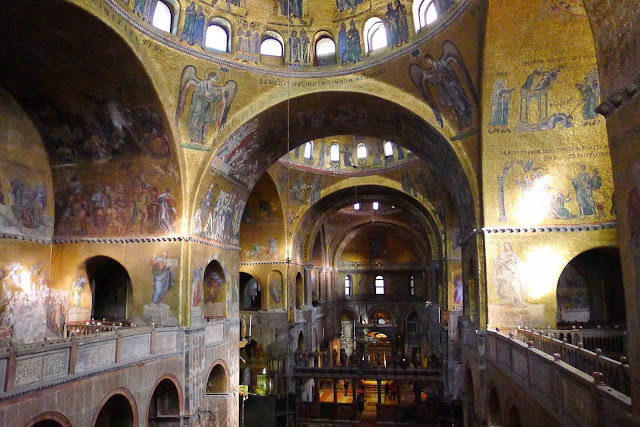
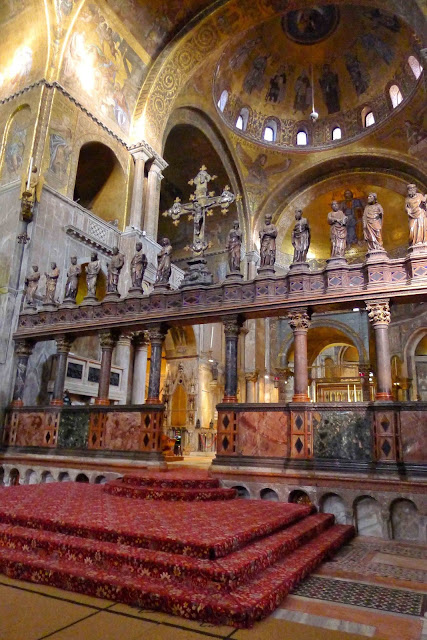















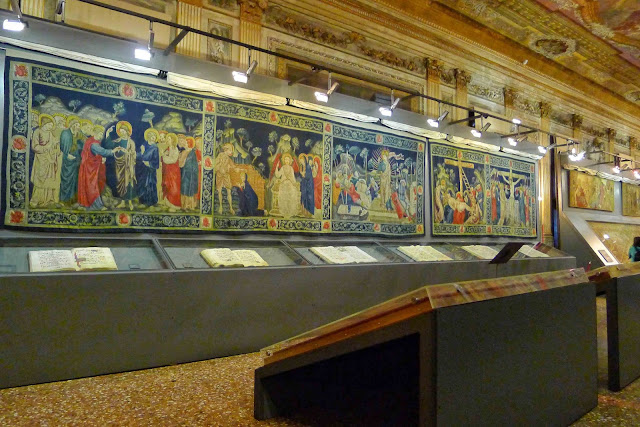
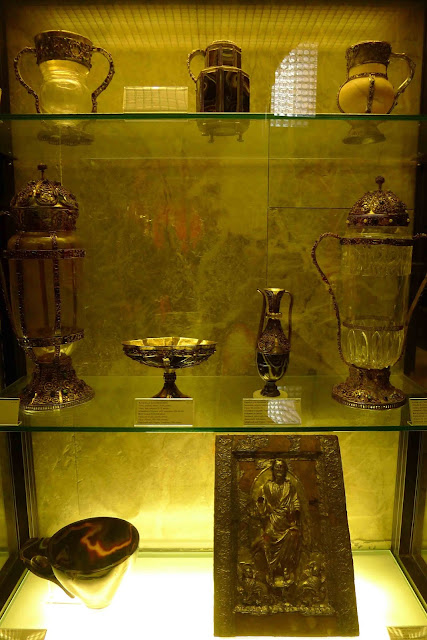





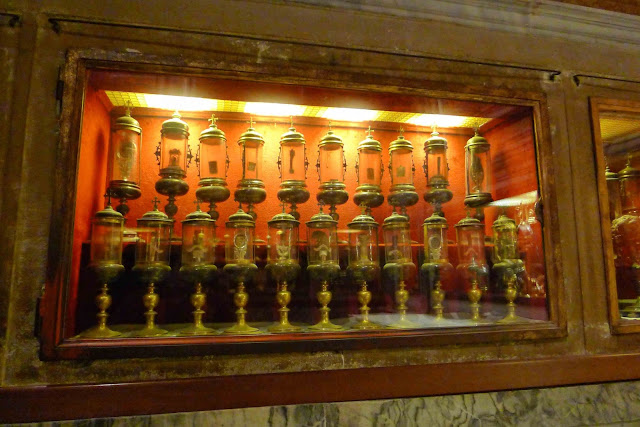



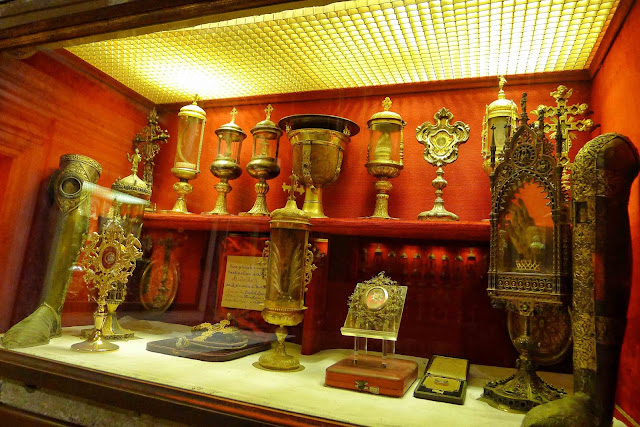




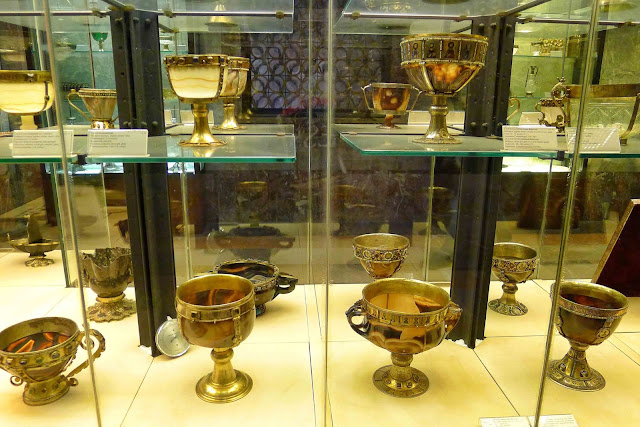





Comments
Post a Comment